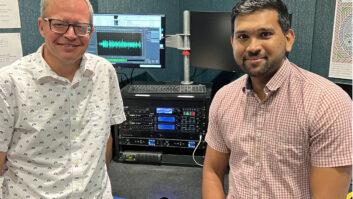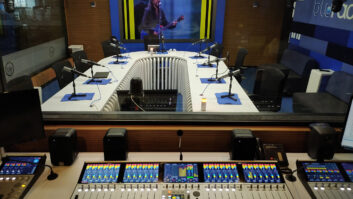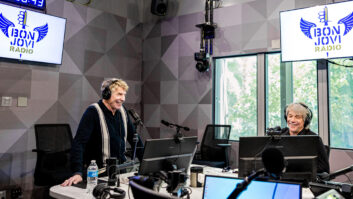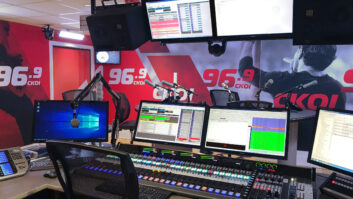There are many paths you may take to get to the production rig of your dreams.
Product CapsuleThumbs Up
Performs under BeOS
Extensive audio and MIDI editing capabilities
Antares Mic Modeler built in
Full-featured mixer surface
Software upgradeable
Thumbs Down
Too many features for straight-ahead radio production
Expensive, given the features that may go unused
Price: $5,999.99
Contact: Tascam in California at (323) 727-4778 or visit www.tascam.com
You can go the budget PC route with a mini-mixer, plow the bucks into a big Mac ProTools system, build a room around an Audicy or consider what the engineers at Tascam call a “digital production environment.”
The Tascam SX-1 is such a choice. This behemoth of a workstation combines an automated 32 x 8 x 8 digital mixer with a hard-disk recorder, full-featured MIDI sequencer, a pile of DSP effects from Tascam and Antares and a CD burner.
And it does so in one very large, very heavy black case that looks flat-out cool as the heart of an audio production system.
Similar workstations are out there; only a few months ago, we checked out the Yamaha AW-4416. With an extra feature here or there, all are immensely powerful and, to a degree, complicated almost to the point of confusion to the radio-minded person. The SX-1 certainly qualifies.
If you are in business creating music for broadcast, commercial production or are doing anything other than day-to-day spot or liner production, this is an excellent system around which to build.
If, on the other hand, you are cutting a spot with voice, sound effects, two music changes and a touch of echo at the end, the SX-1 is excessive and perhaps should not be your first choice at the radio station.
But boy, is it a terrific system for the big projects.
Getting physical
The digital mixer section occupies slightly more than half the work surface of the SX-1. It is fairly simple in appearance: motorized faders, rotary encoder controls and a fistful of illuminated buttons.
Above the mixer, you will find monitor controls and a line of buttons to select Fader Banks. Note there are 16 faders and one Master slider. These buttons let you switch between input channels 1-16, 17-32 and all the group returns and aux busses you can handle. This multifunction approach keeps the mixer to a manageable size.
To the right of center, function buttons switch you through display modes (more on the display coming up), mixer automation, editing and library management. The last item allows you to call up routing configurations and favorite patches, which certainly beats rifling through mystery folders on a standalone computer system.
To the far right there is a multifunction numeric data keypad, a jog/shuttle wheel and nice familiar tape transport buttons to control recording and playback. As on many audio and video products, the jog wheel has a lightweight, fragile feel. For anyone who has ever spun the weighted wheel of a 360 Systems Short/cut or the old Fostex Foundation editor, you know what I mean.
(click thumbnail)Tascam SX-1 Digital Production Environment
Tascam SX-1 Digital Production Environment
The star of the show is the LCD screen that shows track playback, waveforms, mixer functions, DSP settings and more. Perhaps “co-star” is a better choice of words, as the SX-1 is complete when connected to a VGA computer monitor.
We have all marveled at the all-inclusive screens that tell us everything about our digital mixers. But the functions found in the SX-1 really do require a full monitor screen, especially when viewing the multitrack view or the mixer. Indeed, the mixer fills the screen with a remarkably complex virtual console complete with aux sends, dynamics and EQ stages. But with 16 faders filling the screen, the controls are tiny.
There is space on the top of the SX-1 to mount a VGA monitor, but the Tascam manual suggests not doing so with a CRT unit. A flatscreen display is a better choice.
A look around the back reveals the unmistakable layout of a PC backplane – plugs and all – as if someone shoved a computer into a large hole into the SX-1.
Potential customers might consider this a cheap-out: If Tascam can build a system around a common PC – and not even spare the effort to disguise it – why not just buy a PC and get on with life?
Granted, the same thought briefly crossed my mind. But it makes sense. There is no fiscal advantage in Tascam reinventing the wheel and designing computerized innards when OEM hardware has already been perfected and costs less to implement. So what if you can see the backplane? Would it work any differently if a black panel covered it?
Before the “I hate PCs” movement gathers breath, the SX-1 does not run under Windows. Tascam engineers are using BeOS, the Be operating system, which was designed from the outset to be a stable and outstanding multimedia performer.
Actually, the BeOS-driven CPU only serves as a traffic cop for the system. Eight internal SHARC DSPs handle audio computations: six take care of audio routing, EQ, dynamics, bussing and summing. Two DSPs run the plug-in effects, and are split into four quadrants, allowing four stereo effect processors to run at once.
The configuration of the SX-1, therefore, has more in common with a DSP-based ProTools TDM system than it does with a typical PC-based DAW using the CPU for tracks and plug-ins.
Then there is the 88-pound weight of the SX-1. Hoisting a large PC onto a tabletop is tough enough for some people, but two people will be needed to prepare this unit for performance in the studio.
Running it
For anyone who has used a combined audio/MIDI software product such as Cakewalk or Cubase, the idea behind the SX-1 is similar.
Both audio and MIDI data can be recorded, edited, processed and mixed down, then burned to a CD. But do not expect a cute little computer program here. The SX-1 is called a “production environment” for a good reason.
Except for the presence of a keyboard and mouse, the computer never really gets in the way on the SX-1. The BeOS operating system is transparent, so you are literally using a dedicated recording and mixing system, not a PC that just happens to be a music environment at the moment.
Much of what you need to know can be gleaned from the 38-page “Quick Start Guide,” with the longer “Reference Manual” delivering most of the fine details. Read both for best results.
Voice recordings captured with my Earthworks microphone were made a great deal more enjoyable by the application of the Antares Mic Modeler, licensed by Tascam for use in the SX-1. The clinically flat response of the Earthworks microphone was jazzed up with an emulation of a round-sounding Neumann U87.
While I had no U87 with which to do an accurate A/B comparison, the effect nonetheless was impressive. Other great microphones in the preset library include the AKG 414 and the Manley Reference Gold, among others.
Oddly absent were models of the broadcast favorite E-V RE-20 and the classic RCA 77DX, although finding a single mic representative of the entire 77 line has to be impossible today.
Once a sample voice track was committed to the internal hard drive, I went after it with some steep compression, a little over-the-top “smile” EQ and a drop of Boss Jock reverberation, all variable and patchable.
DSP processing on the SX-1 is quite capable, but do not expect spacey Harmonizer-type effects. These are bread-and-butter processing and effect algorithms we all need and depend on.
Music tests consisted of recording a few electric guitar tracks directly into the SX-1, and running some MIDI data via my classic Roland D-50 keyboard and an E-mu Proteus orchestral module. The SX-1 has 128 MIDI tracks and four MIDI Out jacks, which means you may actually get to use that many tracks for a change.
Any recorded audio is subject to the same DSP effects as on voice, so I will not repeat myself here. Know too that the SX-1 was not designed to be a “mini-studio” for musicians; there are no dedicated buffered inputs for instruments, so an electric guitar connected directly to the SX-1 mic inputs will be loaded down by the low-Z inputs and sound muddy.
Expect the standard audio editing conventions of cut, copy, paste, split, clear, reverse and normalize, all nicely implemented on the SX-1. Again, use the VGA monitor to do this – you will quickly appreciate the larger viewing area when doing some hairsplitting.
You may import audio files in WAV, AIFF, SDII, BWAV and AU formats. The SX-1 records and converts to SDII and BWAV formats. Audio quality is 24-bit, 44.1 or 48 kHz sample rate; there is no 96 kHz option, but one is not needed for most general music or radio production.
The SX-1 lacks an internal MIDI sound generator, much as you might find a software synth on a computer soundcard, which is fine. Connect whatever sound generators and modules you want to the MIDI Out jacks without getting locked into the limited set of sounds found on the computer.
I was pleased to see so many features under the MIDI menus, including Piano Roll editing (where note data appears on screen as a series of dots and dashes like on a player piano roll), Event editing and all the cut/copy/pasting I could want. Fleshing out repeated phrases in a music track by grabbing MIDI passages and pasting them into new locations was as effortless as in any other MIDI package out there and a great deal faster.
As radio production does not depend heavily on MIDI, I will not dwell on this aspect of the SX-1. I enjoyed its depth of functions very much, but if you do not need MIDI in your studio, you would just be paying for an expensive feature you would not use.
During my test music recording, I heard a high-pitched noise induced through the guitar pickups whenever I touched a fader. This was due to a touch sensor in the fader that implements an automated function in the unit whenever touched. It was peculiar but not necessarily a problem; nobody can play guitar and run console faders simultaneously unless they have three arms.
Speaking of the faders, may I say bravo. While I have no problem creating mix decisions by drawing “rubberbands” on a track view, having real faders under my fingers remains a wonderfully organic experience. And thanks to the ability of the SX-1 to memorize and automate a mix, it is possible to recall that same mix every time, or to create and save as many variations as you want to.
Besides, clients will love watching those motorized faders move themselves.
Idle port
Extras that have made it onto the Tascam SX-1 include a SCSI port for greater storage capacity, an ADAT-compatible 9-pin I/O connector, time code port and expansion slots for additional optional inputs and outputs as desired.
The unit can sync up to video if desired, with the ability to set frame rates, pullups and pulldowns.
There is also an Ethernet (network) port on the PC backplane. It is idle now, but will be turned on in version 1.5, at which point the SX-1 will function as an FTP server. By giving the machine an address on your network, you will be able to move files back and forth via the FTP.
I don’t know if you are bothered by indicator lights that leave “tails” in the air as your eyes move, but the LEDs on the SX-1 worksurface are clocked at a high rate and flash rapidly. Some may find this fatiguing in a dark control room, some do not. Your call.
In summary, the Tascam SX-1 is a magnificent piece of engineering, with a mixing surface that feels comfortable and serious, and with audio quality you would expect from the folks who have made everything from portable cassette multitracks on up to full-bore studio gear. Editing features are powerful, the on-board DSP keeps you from wishing you had “just one more reverb box,” and the internal CD recorder lets you walk away with a finished product immediately.
I reluctantly must repeat that, for day-to-day radio production, this is not the system for you. The learning curve can be steep, the features intimidating, and the unit’s perceived inability to squirt a finished and labeled piece of production out over the LAN to the audio server make it less desirable than a simple PC/software solution.
Also, cooling fans and disk drive noise might preclude its use up close to a microphone.
Is the six-grand price tag a turnoff? It might be for folks more used to buying PCs and basic DAW software than for users who remember what a quality 16-track reel machine and an effects rack cost only a decade ago. The price seems in line, given the features.
Instead, look to the Tascam SX-1 as a unified production system better suited for the big projects outside of the station: MIDI production music and jingle creation, large-scale multi-mic recording, serious audio mixing and realtime processing. Use it to move into audio-for-video later on. And with software upgrades periodically issued on CD-ROM, the SX-1 will stay fresh and timely for a while to come.













